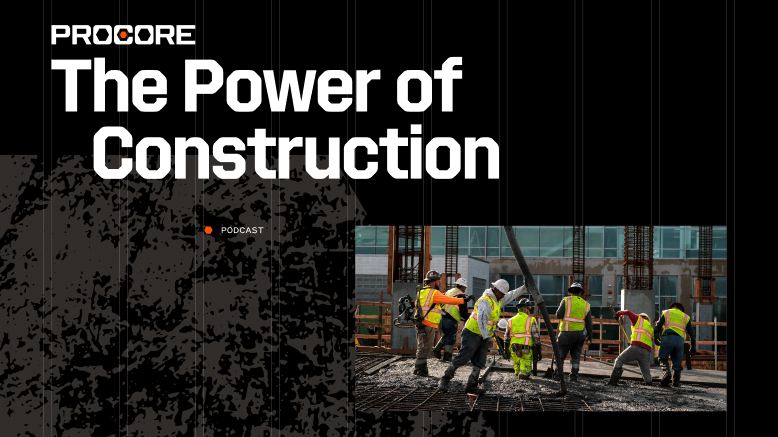— 9 min read
Sealed Bidding in Construction: The Ultimate Guide


Last Updated Jun 6, 2024

Michael Giusti
Michael Giusti is the Journalism Department Chairman and Director of Student Media at Loyola University New Orleans. He has worked as a journalist and writer for more than two decades, covering industries ranging from construction to insurance, finance, and logistics.

Robert Miller
Robert Miller is a Senior Strategic Product Consultant with Procore. He has worked in construction as a project manager for a variety of private companies and public agencies, including Cambridge Housing Authority and the City of Boston. Robert lives in Brooklyn, New York.
Angelique Hamm
Strategic Product Consultant, Owners
Angelique Hamm is a Strategic Product Consultant at Procore. Prior to joining the construction tech firm, Angelique spent three years working as a project engineer at Frymer Construction and Westport Construction. She also has a decade of experience in construction admin, preconstruction project management, and safety and risk management. Angelique is both OSHA 30 and CRIS certified.

Mike Grillo
Head of Surety Advisory
Mike Grillo, a founding partner of Procore Risk Advisors, brings over a decade of experience in construction surety credit underwriting and brokerage. Mike previously served as a Senior Surety Broker at Aon PLC and Assistant Vice President at Zurich North America, aiding middle market and national contractors. Mike resides in Chicagoland with his family.
Last Updated Jun 6, 2024

For public construction in the United States, project owners typically use a sealed bidding process to promote transparency and cost-effectiveness. With this type of procurement, contractors submit sealed bids before a set deadline, and all bids remain confidential until they are opened and read aloud at a public event. Ultimately, the contract is awarded to the contractor with the lowest responsive and responsible bidder — meaning the contractor that submitted the lowest bid and met all other qualifications.
Sealed bidding has advantages for both owners and contractors. Public project owners encourage fair competition with sealed bids, since contractors have a strong incentive to push their prices down as low as possible in order to win the contract. Contractors, on the other hand, are able to compete on price rather than a pre-existing relationship with the project owner, as is common in private construction.
Learn more: A guide to construction bidding
Table of contents
Overview of the sealed bidding process
The sealed bid process is known colloquially as “rip and read,” referring to the day when confidential bids are finally opened and read aloud to the public — which historically was done with physically sealed folders. The unsealing of bids, which will ultimately lead to a contract award, is the culmination of several steps in the sealed bidding process. Each of these steps is designed to promote cost-efficiency, fairness, and transparency.
We’ll look at the five key steps in the sealed bid process: creating a bid package, advertising the project, preparing and submitting bids, opening and evaluating bids, and awarding the contract. Some of these steps are common to all types of bidding, but there are some key differences that make sealed bidding unique.
1. Creating a bid package
Before a public project owner can solicit bids from contractors, they need to put together a bid package, which includes all of the information contractors will need to create an estimate. Typically, a bid package will include several different kinds of information:
- Instructions and overview: Bid form, evaluation criteria, deadlines, site walk-through dates, contact information, RFI process.
- Construction documents: Specifications, drawings, bill of materials or quantities.
- Requirements: Insurance and bonding requirements, evaluation criteria, prequalification criteria, and federal, state, or municipal legal obligations
Public project owners need a very clearly defined scope of work in the project specifications and construction drawings — as this enables them to properly compare bids during the public evaluation.
Some jurisdictions in the United States allow public project owners to use a request for proposals during the sealed bidding process. This approach may enable owners to have a less clearly defined scope of work in order to bring a general contractor on as a construction manager at risk, helping to clarify the building’s design and construction approach.
However, the traditional design-bid-build method is still most common in public procurement, so public project owners will generally use completed drawings and proprietary specifications so that contractors who respond to the invitation to bid are competing on price alone.
2. Advertising the project
The biggest benefit of sealed bidding is that competition drives down prices, so public owners stand to benefit from widely advertising their projects to solicit as many bidders as possible. Additionally, public entities in the United States are generally required by law to advertise their projects in a specific way to promote transparency, fairness, and competition.
Public owners tend to advertise their projects in the following places:
- Newspapers
- Trade publications
- Online bidding platforms
- Government websites
- Construction databases
The entity offering the project will advertise with a sufficient amount of time before bids are due to enable as many contractors as possible to submit bids. Furthermore, legislation may require that the public project owner advertise in a particular way to provide equal representation for women, veterans, minorities, and others.
3. Preparing and submitting bids
Eligible and willing contractors will review the bid package to estimate the project’s cost and prepare a bid. Contractors aim to walk a tightrope when bidding: Bid too high and they won’t win the contract, but bid too low and they won’t be profitable.
Additionally, contractors bidding on public projects have to be mindful of meeting all of the requirements listed in the bid documents. Even if a they submit the lowest bid, a contractor may still lose the contract if they’ve failed to closely follow the tightly regulated guidelines that come along with sealed bidding and government jobs.
In general, contractors look out for the following when preparing a bid for a public project:
- Following the template for formatting and price details
- Competitive pricing for the project
- Bid security and other bonds necessary for submission
- Compliance with federal, state, and local laws regarding diversity, safety, and sealed bid processes
- Timeliness in submitting the bid before the deadline
- Confidentiality by keeping the bid sealed — either physically or with the appropriate electronic system
The actual submission of sealed bids can involve some strategic choices, depending on whether physical or digital bids are required. Often, contractors deliver their bids very close to the deadline. When the project owner requires public unsealing of physical bids, all of the contractors gather at the submission location -- often a government building -- and turn in their bids at the prescribed time.
Because this process is public, contractors can get a good look at the other bidders vying for the project. Some contractors prepare multiple bids, and choose which one to submit at the last moment based on the perceived level of competition. However, this practice is generally not encouraged by public project owners.
Explore data and trends for building materials prices.
Get the latest U.S. retail prices and view historical trends for common building materials.
4. Opening and evaluating bids
Sealed bids are opened at a public event, which is held at a predetermined time, date, and location specified in the bid package. Generally, all contractors who have submitted a bid send a representative to attend the bid opening.
Bids are unsealed either by physically opening sealed envelopes or by disabling electronic systems that keep bids confidential. As each bid is opened, the name of the contractor and the bid price are read aloud. Often, the names of bidders are displayed on a screen arranged from lowest bidder to highest bidder. Depending on the level of competition for a given project, the difference in price between the lowest and second lowest bidders can be as small as a few percentage points.
After all of the bids are read, the “apparent low bidder” has their bid documents more thoroughly scrutinized for irregularities or other disqualifying factors. For example, bids could be invalid for any of the following reasons:
- Late submissions
- Incomplete or missing documents
- Issues with bid security
- Improperly sealed (or unsealed) bid
- Alterations to bid forms
- Conditional bids
- Lack of qualifications
- Collusion
- False or inaccurate information
After all of the documents have been thoroughly evaluated, the lowest responsive and responsible bidder will be awarded the contract after the evaluation of bids. In other words, the lowest bid that meets all of the other criteria set out in the bid package is the winner of the sealed bidding process.
In some jurisdictions in the United States, public owners using a request for proposals can include non-price factors as part of their evaluation criteria. For example, past performance, proposed schedule, safety record, or construction management approach may all be considered relevant factors in selecting the winning bidder.
5. Awarding the contract
After the evaluation process is complete, the public entity providing the project selects the lowest responsive and responsible bidder — or the one that provides the best value, in the case of some requests for proposal. The project owner will send a letter informing the winning bidder of their selection, and all other bidders will receive a letter informing them that their bids were not selected.
In many jurisdictions in the United States, a protest period follows the awarding of the contract. During that time, unsuccessful bidders can challenge the decision or seek clarification on how each bid was evaluated.
Once protests are resolved, the winning bidder begins to negotiate the construction contract with the public project owner. Compared to private construction, public project negotiations tend to be simpler, especially in the case of lump sum contracts. However, the contractor may need to negotiate specifics about scheduling, general conditions of the contract, or other project details.
Learn more: The 5 types of construction contracts
Advantages and disadvantages of sealed bidding
Overall, sealed bidding is a process that public entities in the United States use to encourage competition while maintaining fairness. This process has advantages and drawbacks for both contractors and owners.
| Advantages | Disadvantages |
|---|---|
| Transparency: Open and fair process reduces chances for corruption | Lack of flexibility: Little room for negotiation |
| Competition: Confidential bids encourage contractors to drive down prices | Narrow focus on price: Emphasis on price instead of quality |
| Cost-effective: Public benefits from lower-cost projects | Time-consuming: Lengthy bidding process delays project start |
| Simple evaluation: Straightforward criteria reduces bias and subjectivity | May stifle innovation: Contractors are rarely allowed to propose new solutions or ideas |
| Straightforward rules: All contractors can understand the simple rules of the process | Potential disputes: Possibility for contractor protest may cost time and money |
Contractors who work on public projects find that the simplicity and straightforwardness of the process helps with cost estimates, bid preparation, and contract negotiations. However, those same contractors feel the pressure of lowering their margins to remain competitive, which can lead to quality issues and decrease innovation.
Public project owners value the cost-effectiveness, fairness, and transparency of the sealed bidding process. On the other hand, the process can be complicated when using a request for proposal or including prequalification criteria, which add some subjectivity to the process. In some cases, the possibilities for disputes and protests over the chosen contractor can cost the public time and money, eliminating much of the benefit of sealed bidding.
Over the past few years, sealed bidding across various public entities has become increasingly digital. Especially in the wake of the COVID-19 pandemic, when public “rip and read” events were not permitted, many public sector project owners have begun to see the value of using bid management software to electronically manage sealed bids.
Overall, the sealed bidding process is common in public construction for a reason: The process is fair and transparent while also enabling the government to procure projects at lower prices.
Was this article helpful?
Thank you for your submission.
100%
0%
You voted that this article was . Was this a mistake? If so, change your vote
Scroll less, learn more about construction.
Subscribe to The Blueprint, Procore’s construction newsletter, to get content from industry experts delivered straight to your inbox.
By clicking this button, you agree to our Privacy Notice and Terms of Service.
Thank you!
You’re signed up to receive The Blueprint newsletter from Procore. You can unsubscribe at any time.
Categories:
Written by

Michael Giusti
Michael Giusti is the Journalism Department Chairman and Director of Student Media at Loyola University New Orleans. He has worked as a journalist and writer for more than two decades, covering industries ranging from construction to insurance, finance, and logistics.
View profile
Robert Miller
Robert Miller is a Senior Strategic Product Consultant with Procore. He has worked in construction as a project manager for a variety of private companies and public agencies, including Cambridge Housing Authority and the City of Boston. Robert lives in Brooklyn, New York.
View profileReviewed by
Angelique Hamm
Strategic Product Consultant, Owners
Angelique Hamm is a Strategic Product Consultant at Procore. Prior to joining the construction tech firm, Angelique spent three years working as a project engineer at Frymer Construction and Westport Construction. She also has a decade of experience in construction admin, preconstruction project management, and safety and risk management. Angelique is both OSHA 30 and CRIS certified.
View profile
Mike Grillo
Head of Surety Advisory
Mike Grillo, a founding partner of Procore Risk Advisors, brings over a decade of experience in construction surety credit underwriting and brokerage. Mike previously served as a Senior Surety Broker at Aon PLC and Assistant Vice President at Zurich North America, aiding middle market and national contractors. Mike resides in Chicagoland with his family.
View profileExplore more helpful resources

What Happens When Data Drives the Business?
Construction has long been seen as a low-margin industry. But what if the real problem isn’t the margins—it’s how decisions get made? In episode 17 of The Power of Construction,...

Vet Contractors with Confidence: A Guide to Smart Bidder Selection
Selecting the right bidder is one of the most consequential decisions a construction team makes — yet it often happens under tight deadlines, with limited visibility into the long-term implications....

The Construction Bid Interview & Follow-up: Closing the Deal
During construction project bidding, the interview is often the last part of the request for proposal (RFP) process and one of the most influential. For teams that advance to the...
Construction Business Development: Tracking and Winning the Right Opportunities
Construction business development isn’t just a response to deadlines: It’s a long-term strategy rooted in focus, visibility and timing. Delays, funding gaps and market pressure have made it harder to...
Free Tools
Calculators
Use our calculators to estimate the cost of construction materials for your next project.
Templates
Find a template to help you with your construction project tasks.
Material Price Tracker
Get the latest U.S. retail prices and view historical trends for common building materials.
Glossary
Explore key terms and phrases used in the industry.
